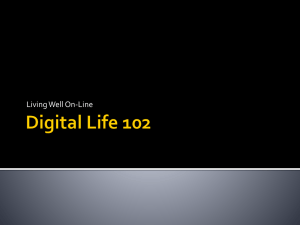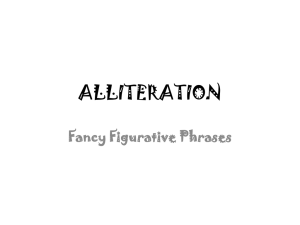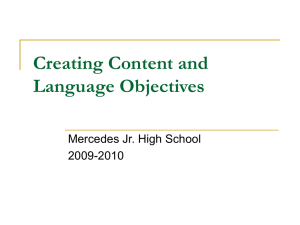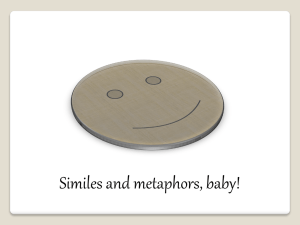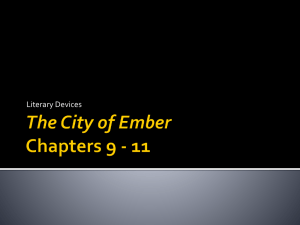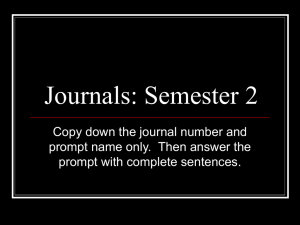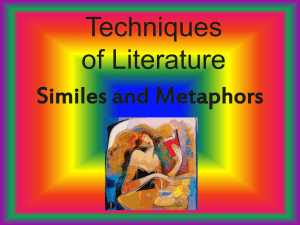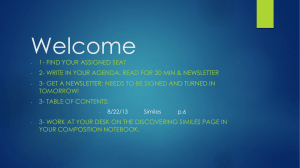Lesson Study Team:
advertisement
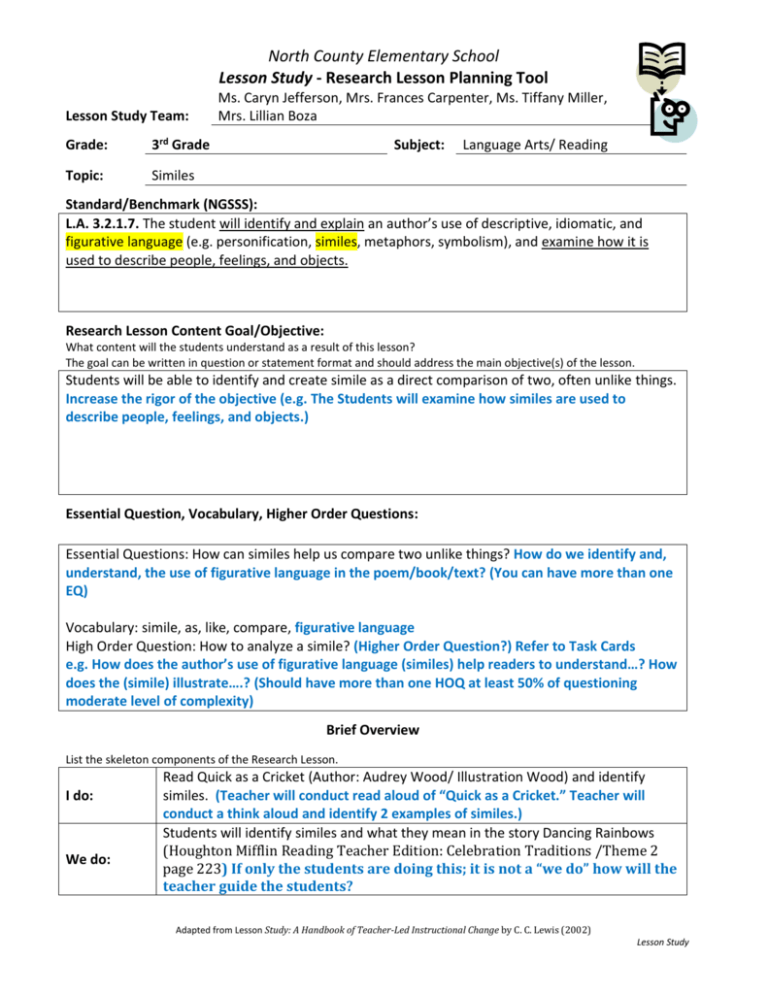
North County Elementary School Lesson Study - Research Lesson Planning Tool Lesson Study Team: Grade: 3rd Grade Topic: Similes Ms. Caryn Jefferson, Mrs. Frances Carpenter, Ms. Tiffany Miller, Mrs. Lillian Boza Subject: Language Arts/ Reading Standard/Benchmark (NGSSS): L.A. 3.2.1.7. The student will identify and explain an author’s use of descriptive, idiomatic, and figurative language (e.g. personification, similes, metaphors, symbolism), and examine how it is used to describe people, feelings, and objects. Research Lesson Content Goal/Objective: What content will the students understand as a result of this lesson? The goal can be written in question or statement format and should address the main objective(s) of the lesson. Students will be able to identify and create simile as a direct comparison of two, often unlike things. Increase the rigor of the objective (e.g. The Students will examine how similes are used to describe people, feelings, and objects.) Essential Question, Vocabulary, Higher Order Questions: Essential Questions: How can similes help us compare two unlike things? How do we identify and, understand, the use of figurative language in the poem/book/text? (You can have more than one EQ) Vocabulary: simile, as, like, compare, figurative language High Order Question: How to analyze a simile? (Higher Order Question?) Refer to Task Cards e.g. How does the author’s use of figurative language (similes) help readers to understand…? How does the (simile) illustrate….? (Should have more than one HOQ at least 50% of questioning moderate level of complexity) Brief Overview List the skeleton components of the Research Lesson. I do: We do: Read Quick as a Cricket (Author: Audrey Wood/ Illustration Wood) and identify similes. (Teacher will conduct read aloud of “Quick as a Cricket.” Teacher will conduct a think aloud and identify 2 examples of similes.) Students will identify similes and what they mean in the story Dancing Rainbows (Houghton Mifflin Reading Teacher Edition: Celebration Traditions /Theme 2 page 223) If only the students are doing this; it is not a “we do” how will the teacher guide the students? Adapted from Lesson Study: A Handbook of Teacher-Led Instructional Change by C. C. Lewis (2002) Lesson Study North County Elementary School Lesson Study - Research Lesson Planning Tool You do: Students will create similes of their own. Page 1 of 3 Continue on next sheet. Adapted from Lesson Study: A Handbook of Teacher-Led Instructional Change by C. C. Lewis (2002) Lesson Study North County Elementary School Lesson Study - Research Lesson Planning Tool Detailed Steps of the Research Lesson*: *This section is to be completed on a separate sheet (p. 3). Prerequisite Knowledge: What skills, concepts, or background knowledge do the students need to have in order to be successful participants in this lesson? Students will need to be familiar with sight words such as like or as. Are these the only prerequisites that students will need to be successful in the lesson? Materials and Resources: Quick as a Cricket, Sentence Strips, Houghton Mifflin Reading Teacher Edition: Celebration Traditions /Theme 2, Paper, Pencils, Poem, Assessment Teacher who will present our lesson: Ms. Jefferson Observation Date: Debriefing Date: December 7, 2010 December 8, 2010 Time: 9:00-10: 30 Time: 1: 50pm Page 2 of 3 Adapted from Lesson Study: A Handbook of Teacher-Led Instructional Change by C. C. Lewis (2002) Lesson Study North County Elementary School Lesson Study - Research Lesson Planning Tool Lesson Study Team: Topic: Jefferson, Carpenter, Miller Grade: 3 Subject: Language Arts/ Reading Similes Expected Student Reactions or Responses I don’t understand what we are comparing. Learning Activities Directions: Step One: Teacher introduces objective of the lesson. Students this is what we will be learning today… Can we use like and as in a simile? Assessment* and Home Learning Assessment: Create Similes Home Learning: Simple Similes Answer: We can use as or like in a simile. What is a simile? Answer: A simile is a comparison that uses like or as. Introduce the Essential Question. Essential Question: How can simile help us compare two unlike things? Step Two: Read the first four pages of the book Quick as a Cricket. Author: Audrey Wood Teacher’s Response to Student Reactions / Things to Remember Example: Hungry as a pig. Do we know how hungry a pig is? Are we pigs? No, but we do know that they eat a lot. What two things are being compared? What point is the writer trying to make? Children may wish to take notes and brainstorm ideas. It is important for young readers to stop and think as they read and not ignore or skip a challenging word or sentence. If students finish early they can create a simile and it will be placed on a sentence strip in the class. Step Three: What was compared in the story? (Think Aloud) (I am sure there were many things Adapted from Lesson Study: A Handbook of Teacher-Led Instructional Change by C. C. Lewis (2002) Lesson Study North County Elementary School Lesson Study - Research Lesson Planning Tool compared in the story, choose one or two to identify and conduct think aloud on those as the “I DO” Step Four: Have students identify similes on page 223. Answers: Shells sound like waves hitting the shore. Tassels look like rain drops. Bells sound like falling rain. Embroider designs look like clouds. Step Five: Students will orally give a simile. Step Six: Students will underline what two things are being compared in each simile in the poem. Step Seven: Simile Assessment Step Eight: If students finish early they can create a simile and it will be placed on a sentence strip in the class. (the lesson only brings students to the point of identifying and creating/developing, refer back to Adapted from Lesson Study: A Handbook of Teacher-Led Instructional Change by C. C. Lewis (2002) Lesson Study North County Elementary School Lesson Study - Research Lesson Planning Tool the benchmark NGSSS.) Align objective with the NGSSS. Where will Higher Order Questioning take place? What collaborative structure could be implemented to build the level of student engagement? Does the group plan to incorporate technology? Detailed Steps of the Research Lesson: * Lesson Study Cycle Page 3 of 3 Adapted from Lesson Study: A Handbook of Teacher-Led Instructional Change by C. C. Lewis (2002) Lesson Study North County Elementary School Lesson Study - Research Lesson Planning Tool Learning Activities and Questions Expected Student Reactions or Responses Teacher’s Response to Student Reactions / Things to Remember Assessment* and Home Learning Assessment : * Lesson Study Cycle Adapted from Lesson Study: A Handbook of Teacher-Led Instructional Change by C. C. Lewis (2002) Lesson Study
